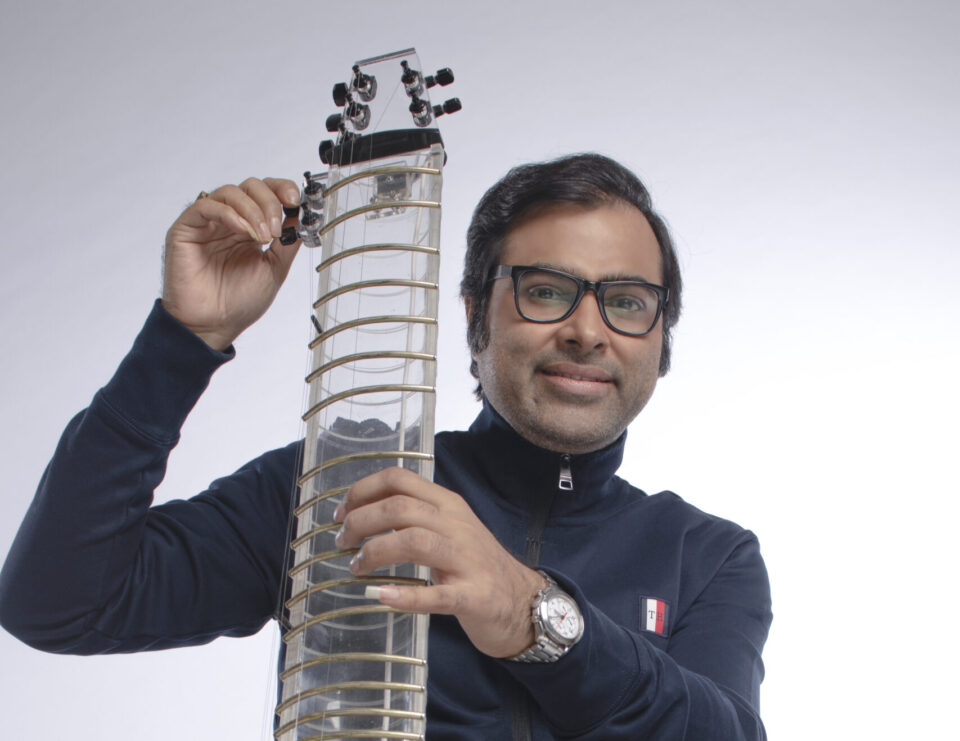Watch Purbayan Chatterjee Bring Out Electric See-tar for ‘Two Thirds’ Jam with Taufiq Qureshi and Bernhard Schimpelsberger
Recorded at the Purbayan Art and Artists Music Foundation studios in Mumbai, the performance also features keyboardist Nakul Chugh
Beyond training students, the Purbayan Art and Artists Music Foundation (PAAMF) in Mumbai – set up by composer and sitarist Purbayan Chatterjee – is the artist’s way of giving back. Launched early this year by Chatterjee and vocalist Gayatri Asokan (also his wife), PAAMF is a studio and performance space, which is also equipped to make content for digitally-informed classical artists of tomorrow.
Chatterjee has been teaching students for long, but with PAAMF, he says they will get a “better space to not only learn in but to craft effective and potent careers from.” He adds, “The foundation strives to pollinate the digital space with top quality, Indian music and arts. We have the wherewithal to shoot and record experimental forms of music.”
He leads by example in a way, with the release of “Two Thirds,” a performance shot at the PAAMF studios between Chatterjee, percussionist Taufiq Qureshi on the djembe, British-Australian drummer Bernhard Schimpelsberger and keyboardist Nakul Chugh. Schimpelsberger – a longtime friend of Chatterjee – was visiting the artist in Mumbai and thus made a plan to not just visit PAAMF studio but also make some music. Chatterjee adds about the collaborators, “Taufiq Qureshi is like family for us and he has always been very supportive and encouraging right from the days when I made my album, String Struck. Nakul has been a part of many of my projects and therefore it was logical to have him in the PAAMF studios to try and create some music together with Bernhardt and Taufiq bhai.”
Starting with the hook line and playing around with over the course of a few rehearsals, “Two Thirds” is aptly heightened by the use of Chatterjee’s see-tar, a see-through electric sitar that the artist only sparingly uses. Designed a decade ago to enhance the visual appeal of his performances, Chatterjee explains that he only uses it occasionally when the song demands it. “This is a plexiglass sitar and therefore highly suited to being run through a processor to create a vast variety of ambient sounds as well as edgy sounds using overdrive […] I felt that it was appropriate that I use this into ‘Two Thirds’ because I wanted to have an edgy and racy kind of sound,” Chatterjee says.
Among the first recordings at PAAMF studios, Chatterjee will release more material from “other very interesting projects” in the coming months. One of them, surprisingly, is a trance album. Unsurprisingly, it was in Goa that Chatterjee was drawn to trance music as a style. He adds, “It is normally seen as a rave party kind of genre, but I feel like it has an energy that can be used for so much more. This collaboration, which is being produced by Nakul Chugh, is going to feature a couple of international stars and this is a project which is very close to my heart.”
He’s also revisiting his 2008 album Shastriya Syndicate, with a whole new lineup of artists. While the original album included the likes of flautist Rakesh Chaurasia, veena artist Jayanthi Kumaresh and others, there will be younger artists jamming with Chatterjee this time around. “We are also incorporating a lot of elements of production using modern sounds to showcase Indian classical music. I will be able to divulge more details about them in the months to follow,” he adds.
Watch the video for “Two Thirds” below.




